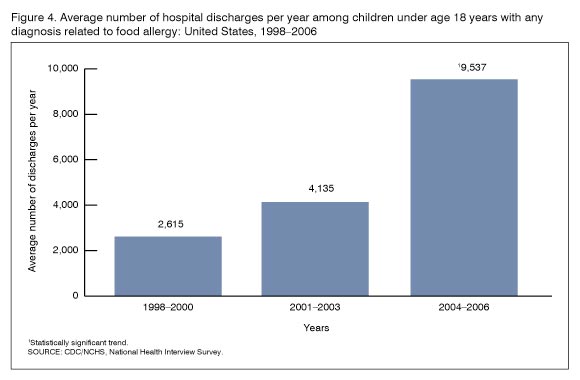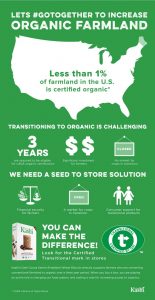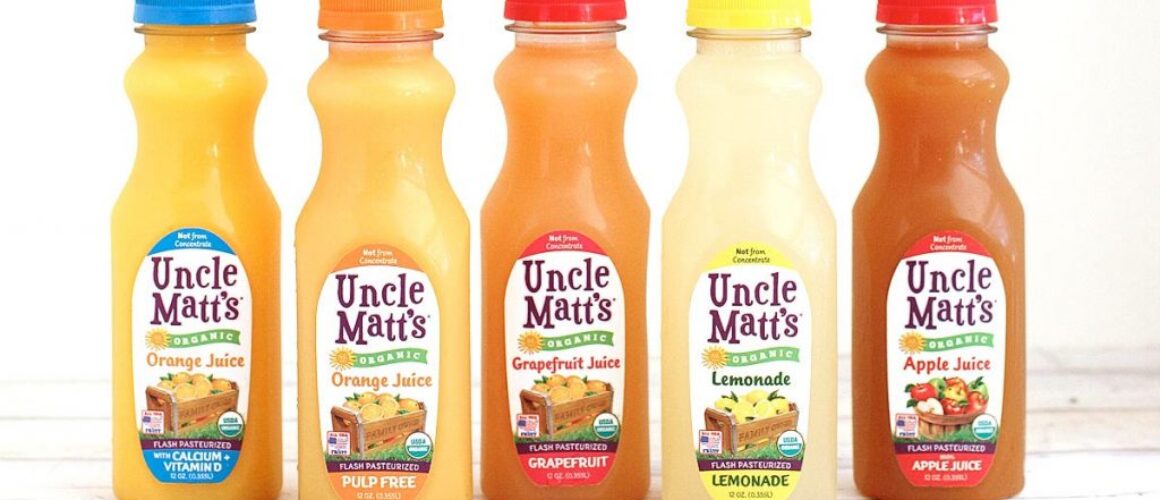U.S. of Allergies: The Cost of Food Allergies in America
 Next week, I’m doing a cooking segment for a TV show that targets families. The producer left a message last night, asking about how we can work some questions into the segment. It’s such an important conversation, and it got me thinking.
Next week, I’m doing a cooking segment for a TV show that targets families. The producer left a message last night, asking about how we can work some questions into the segment. It’s such an important conversation, and it got me thinking.
Today, 8 in 10 families are now purchasing some organic products. But less then 1% of our farmland in the U.S. is organic. That’s nuts, and what ends up happening is instead of supporting our own American farmers, we import what Americans are now eating. There is something called the Farm Bill that brings all of these issues to light. And our farmers need help there, to know that organic isn’t a fad or trend.
Why? Because food allergies, pediatric cancers, autism and other conditions impacting our kids aren’t trends either.
Private insurance claim lines with diagnoses of anaphylactic food reactions rose 377 percent from 2007 to 2016, according to a recent report.
The report, by FAIR Health, found that peanuts were the most common food specified to cause anaphylaxis, accounting for 26% of the claims. However, the largest percentage of claims were from a category titled “other foods,” accounting for 33%.
Eggs were 7%, crustaceans 6%, milk 5%, fish 2%, fruits and veggies 2% and food additives 1%.
The increase in claims was greater in rural areas (110%) than urban (70%) areas, challenging recent claims that food allergies were less common in rural areas.
The report also highlighted that food allergies are far more pervasive across age groups than previously understood. About 66% of claims were for patients 18 and younger, but 34% impacted those over the age of 18.
Add this data from 2007–2016 to the fact that the number of people with the peanut allergy in the United States more than quadrupled between 1997 and 2010 and it is obvious that we have a crisis.
Food allergies are not a niche, it is a growing epidemic that is challenging how we think about our food and how it is made. Genetic factors don’t change this quickly, environmental factors do. Are we allergic to food or to what’s been done to it?
Researchers reporting in the Journal of the American Medical Association states that the costs of food allergies, from medical care to food to pharmaceuticals is $4,184 per child per year, costing our economy $25 billion, including lost productivity.
To discount this condition in any way is irresponsible, but it is just one of the conditions that is triggering a food awakening around the country.
In the United States, we are quickly learning that our food supply contains a lot of ingredients that simply did not exist when we were kids, and that our own American corporations don’t use these ingredients in the products they sell overseas.
From artificial food dyes created in a laboratory to genetically engineered foods now regulated by the EPA as pesticides, we are finding our food supply increasingly hopped up on new ingredients. And if the market is any indication, a growing number of consumers don’t want it this way.
A recent study, funded in part by the peanut industry, stirred controversy when it suggested feeding peanuts to infants. A New York Times story profiled a lawmaker who “discounted the correlations between the rise in childhood allergies and the consumption of G.M.O.s.”
Both triggered an allergic reaction in 21st century consumers with this condition. 21st century consumers are looking for “free from” food: food that is free from ingredients like high fructose corn syrup, GMOs and artificial ingredients. Why? Because we are dealing with conditions and diseases in our families like never before. It is driving a food awakening. We are not saying that correlation is causation, we simply want food companies to dump the junk and the artificial ingredients from their products.
In the last few years, Target, Chipotle, Kroger, even General Mills and Cheerios have responded to this growing demand in the marketplace. In the last week, Pepsi, Tyson and others have responded, too.
They see the escalating rates of diseases, they feel the financial impact with their own health care costs, and they hear consumers that are saying they want to eat fewer fake, artificial and genetically engineered ingredients. While the chemical companies selling these new ingredients say there is no evidence of harm, consumers are saying: there is no evidence since these ingredients were never labeled in the United States. There are also no long term studies to show us that they are safe.
The potential of genetically engineered foods to cause allergic reactions is a big reason for opposition to these crops. It is also one of the concerns that led 64 countries around the world to label these foods for their citizens while 27 countries banned them entirely.
Introduced into the US food supply in the mid 1990s without labels, there were protocols put in place to ask questions about the allergy-causing possibilities, but there has been no test that offers definitive answers.
In other words, if you walked into an allergist’s office and asked if you were allergic to corn that has been in the food supply for thousands of years or if you are allergic to a new corn product, genetically engineered to produce its own insecticide and introduced into our food and now regulated by the EPA as a pesticide, there would be no test to give you that answer.
With no labels on these ingredients in the US to trace their impact and no test to offer definitive answers, the biotech industry is able to claim that there is not a single documented case of these foods ever causing harm. Don’t ask, don’t tell.
But with the widespread introduction of genetically engineered ingredients into the US food supply, a frequently asked question is: Are rates of allergies higher in the United States than they are in other countries?
Previously, it was anyone’s guess.
But a study released in the Journal of the American Medical Association, says yes, living in the United States increases your risk of allergic diseases……“significantly.”
“Living in the US raises risk of allergies,” says the headline.
According to the research, living in the United States for a decade or more may raise the risk of some allergies, reports the Journal of the American Medical Association.
“These data indicate that duration of residence in the United States is a previously unrecognized factor in the epidemiology of atopic disease,” it said.
In other words, the longer you live here, the more likely you are to develop some kind of allergy, asthma, eczema or other related condition.
Food allergies have been skyrocketing in the United States in the last fifteen years. Not only has the CDC reported a 265% increase in the rates of hospitalizations related to food allergic reactions in a ten year period, but the sales of EpiPens, a life-saving medical device for those with food allergies, has also seen record sales growth according to the New York Times.
So what’s going on?
The study aimed to find out. Allergies reported in the survey included asthma, eczema, hay fever, and food allergies.
“Children born outside the United States had significantly lower prevalence of any allergic diseases (20.3%) than those born in the United States (34.5%),” said the study led by Jonathan Silverberg of St. Luke’s-Roosevelt Hospital Center in New York.
Let’s restate that:
Children born in the US have more than a 1 in 3 chance of having allergic diseases like food allergies, asthma or eczema, while kids born in other countries around the world had a “significantly lower prevalence” of 1 in 5.
On top of that, “foreign-born Americans develop increased risk for allergic disease with prolonged residence in the United States,” it said.
In other words, if you move here, your chances of developing any one or more of these allergic diseases increase.
The study went so far as to say that children born outside of the US who moved here showed “significantly” higher odds of developing these diseases.
What’s driving this? Is it really Purel and intense handwashing? And the hygiene hypothesis?
And are we allergic to food? Or what’s been done to it?
Because genetics don’t change that quickly, and the environment does.
“These data indicate that duration of residence in the United States is a previously unrecognized factor in the epidemiology of atopic disease,” it said.
This presents a risk not only to these children, but also to our economy, as the financial burden of these conditions and their associated health care costs impact not only families but also our country, our military and our productivity.
So what is triggering this escalating, US allergy epidemic?
According to Reuters report on the study and Dr. Ruchi Gupta, who studies allergies at the Northwestern University Feinberg School of Medicine in Chicago but wasn’t involved in the new research, “This is definitely something we see clinically and we’re trying to better understand, what is it in our environment that’s increasing the risk of allergic disease?” said
“Food allergies have increased tremendously,” she told Reuters Health. “We do see people who come from other countries don’t tend to have it.”
As discussed in a previous column, allergic reactions occur you’re your body perceives something to be a threat. They can also be a symptom of a hypersensitive immune system – our bodies armed and ready to launch an attack againstany perceived threat.
A growing number of doctors are also suggesting that food allergies might be a symptom that something is wrong with our food system. In other words, in light of the sudden explosion in food allergies: are we suddenly allergic to food? Or what’s been done to it?
Someone with food allergies has an immune system that perceives a food protein to be “foreign”, unidentifiable. And it launches an inflammatory response to drive out that foreign invader.
Today, we have new, foreign proteins that have never existed in our food supply that have been genetically engineered into our food. These proteins are so new that they have been patented by the United States Patent and Trademark Office and never before existed up until their introduction in the late 1990s and early 2000s.
Now correlation is not causation, but the concern over the unknown health impacts of these new proteins in the food supply is in part what led 64 countries around the world to label genetically engineered foods when they were first introduced fifteen years ago and 27 countries to flat out ban them.
According to Science Daily:
Genetically engineered crops are created by inserting a protein from a different organism into the original crop’s genome. This is usually done to create a plant that is more resistant to insects or diseases.
The Food and Agriculture Organization within the World Health Organization has a structured approach to determining whether genetically engineered foods cause allergies, according to Venu Gangur, MSU assistant professor of food science and human nutrition, who also is a faculty member in the National Food Safety and Toxicology Center. “But it has a major flaw. A critical question in that process asks, ‘Does the protein cause an allergic reaction in animals?’ The problem is that there has been no good animal model available to test this.”
It’s food for thought.
We don’t have labels on these genetically engineered foods in the US, at least not yet. Bipartisan legislation was recently introduced, and efforts have been made to urge the FDA to take action so that American consumers can enjoy the same freedoms enjoyed by consumers in over 60 countries around the world (including all of the member states of the European Union, Australia, Japan, the UK, Russia, China and India) and have access to whether or not their food and the foods they are feeding their families contain these genetically engineered ingredients.
Do we really want out slogan to be: Come to America, but don’t forget your asthma enhalers and EpiPens? We could quickly earn the title of the United States of Allergic Disease.
We are so much more than that.
Since genetically engineered ingredients are not yet labeled here in the United States. look for “Non-GMO” or “USDA Organic” foods which by law are not allowed to be produced with these new proteins. Chipotle took a bold move and announced that they are dropping these ingredients altogether.
With conflicting positions in the science, these ingredients need to be labeled. A food allergic reaction sends someone to the emergency room in the United States once every three minutes. European law dictates that any food containing more than 0.9% genetically engineered ingredients be labeled as containing GMOs. It’s a freedom to choose. Clean food is a right that should be afforded to all Americans, not just those who can afford to opt out and purchase foods labeled “non-GMO” or “USDA Organic”.
Mounting scientific evidence points to the role that our increasingly re-engineered food supply, hopped up on additives, artificial dyes, artificial growth hormones, record amounts of pesticides now recognized by the World Health Organization as a probable carcinogen and genetically engineered ingredients hardwired to be sprayed with them is having on the health of our families. The growing number of American dealing with food allergies and food sensitivities is an alarm bell that our bodies can no longer tolerate what has been done to our food.
The cost of food allergies is burdening more than just the families dealing with them, it’s burdening our schools, our health care system and our economy.
Food allergies are not a “niche,” just as cancer is not a fad.
It’s time to clean up our food, to get the junk out. So many big companies now recognize this and are responding to the needs of 21st century families.
21st century consumers are looking for food that is free from artificial ingredients and allergens. The companies that recognize this are seeing their market share and earnings grow.
Our kids are the compass.












 “Since 1969, dozens of studies of food-grade carrageenan have been published in peer-reviewed academic journals. Results from these scientifc experiments point to harmful effects from food-grade carrageenan in the diet.
“Since 1969, dozens of studies of food-grade carrageenan have been published in peer-reviewed academic journals. Results from these scientifc experiments point to harmful effects from food-grade carrageenan in the diet.
